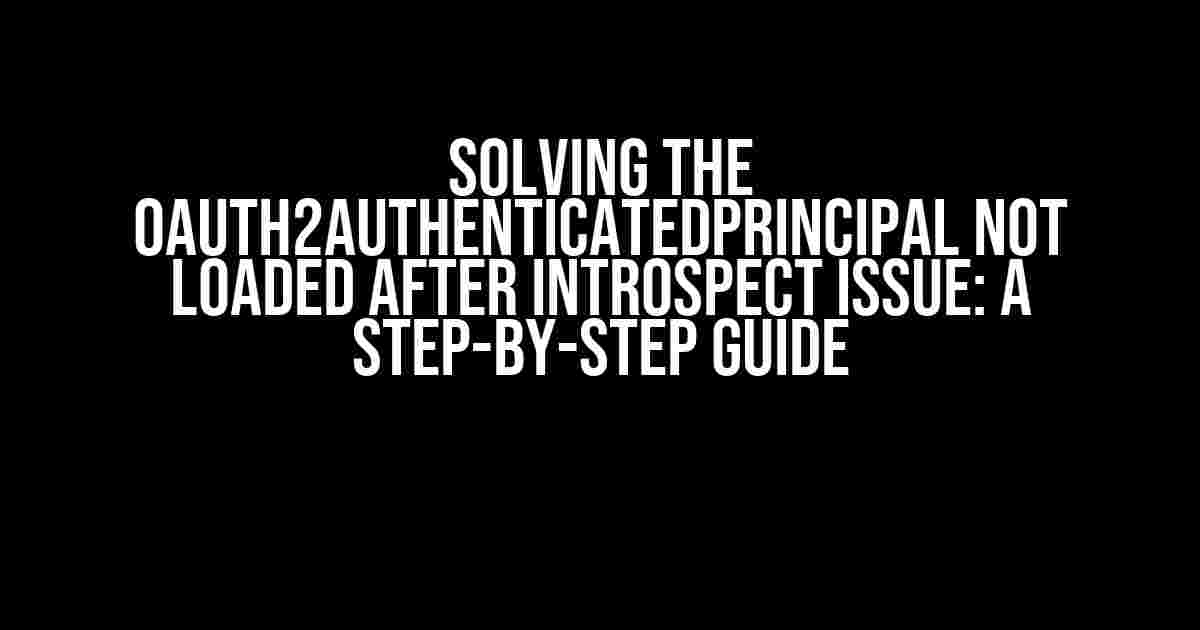Are you tired of struggling with the elusive OAuth2AuthenticatedPrincipal not loading after introspect is executed? You’re not alone! This frustrating issue has plagued many developers, leaving them scratching their heads and questioning their coding skills. Fear not, dear reader, for we’ve got you covered. In this comprehensive guide, we’ll delve into the world of OAuth2 and dissect the problem, providing clear and actionable solutions to get you back on track.
What is OAuth2AuthenticatedPrincipal?
Before we dive into the solution, let’s quickly cover the basics. OAuth2AuthenticatedPrincipal is a Spring Security component that represents the authenticated user in an OAuth2 flow. It encapsulates the user’s details, including their username, authorities, and any additional attributes fetched from the authentication server. When an introspect request is executed, the OAuth2AuthenticatedPrincipal is expected to be loaded with the user’s information. However, in some cases, this principal may not be loaded, leading to the issue at hand.
Causes of the Issue
So, why does the OAuth2AuthenticatedPrincipal not load after introspect is executed? There are several reasons for this issue, including:
- Incorrect configuration of the OAuth2 resources or clients
- Misconfigured introspect endpoint URLs or credentials
- Incompatibility between the OAuth2 provider and the Spring Security version
- Faulty implementation of the OAuth2AuthorizedGrantTypes
- Missing or incorrect dependencies in the project’s pom.xml file (for Maven-based projects) or build.gradle file (for Gradle-based projects)
Solution 1: Verify OAuth2 Configuration
The first step in solving the issue is to thoroughly review your OAuth2 configuration. Double-check that you’ve correctly set up your OAuth2 resources, clients, and introspect endpoint URLs. Ensure that you’ve provided the necessary credentials, such as the client ID, client secret, and token URI.
security:
oauth2:
client:
registration:
custom-client:
client-id: your-client-id
client-secret: your-client-secret
authorization-grant-type: authorization_code
redirect-uri-template: '{baseUrl}/login/oauth2/code/{registrationId}'
scope: openid profile email
provider:
custom-provider:
authorization-uri: https://your-authorization-server.com/oauth/authorize
token-uri: https://your-token-server.com/oauth/token
user-info-uri: https://your-user-info-server.com/userinfo
user-name-attribute: username
Solution 1.1: Check Introspect Endpoint Configuration
Verify that you’ve correctly configured the introspect endpoint URL and credentials. Ensure that the introspect endpoint is properly set up to return the user’s information.
security:
oauth2:
client:
registration:
custom-client:
...
provider:
custom-provider:
...
introspect-uri: https://your-introspect-server.com/oauth/introspect
introspect-auth-username: your-introspect-username
introspect-auth-password: your-introspect-password
Solution 2: Verify Spring Security Version Compatibility
Ensure that your Spring Security version is compatible with the OAuth2 provider you’re using. Incompatible versions can lead to issues with the OAuth2AuthenticatedPrincipal loading.
<dependency>
<groupId>org.springframework.boot</groupId>
<artifactId>spring-boot-starter-security</artifactId>
</dependency>
<dependency>
<groupId>org.springframework.boot</groupId>
<artifactId>spring-boot-starter-oauth2</artifactId>
</dependency>
Solution 3: Implement OAuth2AuthorizedGrantTypes Correctly
Verify that you’ve correctly implemented the OAuth2AuthorizedGrantTypes. This configuration determines the grant types allowed for the OAuth2 flow.
@Configuration
@EnableWebSecurity
public class SecurityConfig extends WebSecurityConfigurerAdapter {
@Override
protected void configure(HttpSecurity http) throws Exception {
http.oauth2Login()
.userInfoEndpointUrl("/userinfo")
.userNameAttribute("username")
.and()
.oauth2AuthorizedGrantTypes("authorization_code", "refresh_token");
}
}
Solution 4: Check Dependencies
Ensure that you’ve included the necessary dependencies in your project’s pom.xml file (for Maven-based projects) or build.gradle file (for Gradle-based projects).
<dependency>
<groupId>org.springframework.boot</groupId>
<artifactId>spring-boot-starter-security</artifactId>
</dependency>
<dependency>
<groupId>org.springframework.boot</groupId>
<artifactId>spring-boot-starter-oauth2</artifactId>
</dependency>
<dependency>
<groupId>org.springframework.security</groupId>
<artifactId>spring-security-oauth2</artifactId>
</dependency>
Solution 5: Debug and Troubleshoot
If none of the above solutions work, it’s time to dive deeper into debugging and troubleshooting. Enable debug logging to get more insights into the OAuth2 flow.
logging:
level:
org.springframework.security: DEBUG
Analyze the logs to identify any errors or exceptions related to the OAuth2 flow. Check the introspect endpoint response to ensure it returns the expected user information.
Conclusion
In conclusion, the OAuth2AuthenticatedPrincipal not loading after introspect is executed issue can be frustrating, but it’s not insurmountable. By following the step-by-step guide outlined in this article, you should be able to identify and fix the root cause of the problem. Remember to verify your OAuth2 configuration, check for Spring Security version compatibility, implement OAuth2AuthorizedGrantTypes correctly, ensure correct dependencies, and debug and troubleshoot as needed.
| Solution | Description |
|---|---|
| 1. Verify OAuth2 Configuration | Review and correct OAuth2 resources, clients, and introspect endpoint URLs. |
| 2. Verify Spring Security Version Compatibility | Ensure compatible Spring Security version with OAuth2 provider. |
| 3. Implement OAuth2AuthorizedGrantTypes Correctly | Configure OAuth2AuthorizedGrantTypes for allowed grant types. |
| 4. Check Dependencies | Verify necessary dependencies in pom.xml or build.gradle file. |
| 5. Debug and Troubleshoot | Enable debug logging and analyze logs for errors or exceptions. |
By following these solutions, you should be able to resolve the OAuth2AuthenticatedPrincipal not loading after introspect is executed issue and get your OAuth2 flow working seamlessly.
Frequently Asked Question
Q1: What is OAuth2AuthenticatedPrincipal and why is it important?
OAuth2AuthenticatedPrincipal is a Spring Security principal that represents an OAuth 2.0 authenticated user. It’s crucial because it holds the user’s authentication details, allowing your application to authorize requests and access secure resources. Without it, your app won’t know who the user is or what they’re allowed to do!
Q2: Why isn’t OAuth2AuthenticatedPrincipal loaded after introspect is executed?
This might happen if the introspection response doesn’t contain the necessary user information or if the OAuth2AuthorizedGrantTypes aren’t properly configured. Double-check your OAuth 2.0 configuration and introspection response to ensure that the user details are being passed correctly!
Q3: How do I debug OAuth2AuthenticatedPrincipal not being loaded?
Enable debug logging for the OAuth 2.0 and Spring Security packages. This will help you identify the issue by providing more detailed logs. You can also use a debugger to step through the authentication process and inspect the introspection response.
Q4: Can I use a custom OAuth2UserService to load the OAuth2AuthenticatedPrincipal?
Yes, you can! Implementing a custom OAuth2UserService allows you to load the OAuth2AuthenticatedPrincipal programmatically. This can be useful if you need to perform additional processing or mapping of the user details. Just be sure to register your custom service in the Spring Security configuration!
Q5: What are some common causes of OAuth2AuthenticatedPrincipal not being loaded?
Common culprits include incorrect OAuth 2.0 configuration, missing or invalid user information in the introspection response, and misconfigured Spring Security settings. Also, ensure that the OAuth 2.0 token is valid and not expired!
